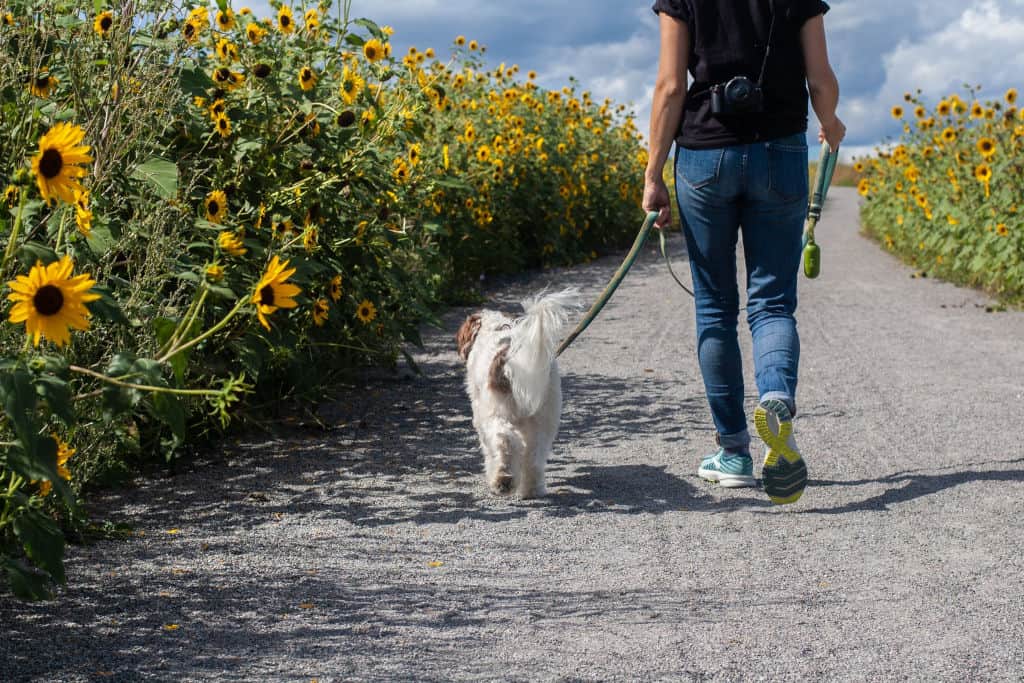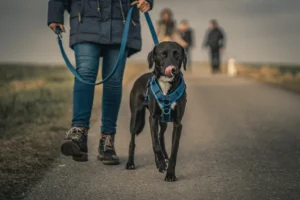Whether dogs like leashes will mostly depend on how the leash is used and how well-trained and socialized the dog is.
This article explores whether dogs like being on leashes, whether there are any benefits off-leash, and whether you should walk the dog leashed or off-leash.

Do Dogs Like Being on a Leash?
Whether a dog prefers being on a leash largely depends on the individual dog and their experiences with leashes and the training and behavior techniques used. Some dogs may view a leash as a symbol of restriction, while others may associate it with safety and security.
Dogs that have been well-socialized, trained, and habituated to wearing a leash are likely to feel more comfortable in this situation. On the other hand, dogs with negative experiences with leashes, such as being yanked or pulled, may view leashes as a source of stress and discomfort.
Even if a dog doesn’t necessarily enjoy being on a leash, it can still be necessary to keep them safe and secure.
Ultimately, dogs are creatures of habit, and with proper training and conditioning, many dogs can learn to enjoy being on a leash. In fact, a consistent routine, paired with positive reinforcement during leash training, often leads to dogs eagerly anticipating their leash walks.
Are Dogs Happier When They’re off-leash?
Off-leash playtime can bring dogs happiness and joy, allowing them to run, explore, and interact with their environment more naturally.
Whether or not a dog is happier off-leash depends on several factors, including their personality, training, and experience.
First of all, most dogs enjoy going for walks. They get to see and smell new things, leave their comfortable surroundings, and, most importantly, go somewhere with you. It’s bonding time.
A leash can provide positive reinforcement in this regard. Because of this, dogs can get excited when they see leashes.
For some dogs, being off-leash can be a source of anxiety, as they may feel exposed and vulnerable without the security and structure that a leash provides. For others, the freedom of being off-leash can bring a sense of excitement and adventure.
Remember, a dog’s perception of being off-leash is rooted in its past experiences, so initial controlled, positive off-leash sessions can set the tone for future outings.
You can train them on a loose leash, too, with our guide. It’s simple really, just follow the steps listed in there.
Ultimately, whether a dog is happier off-leash or on-leash depends on the specific situation and the individual dog.
Is It Better to Walk Your Dog on a Leash or Without One?
In an ideal world, all dogs could go on lengthy, off-leash walks where they could smell, potty, and investigate their surroundings. This, however, is rarely possible, especially in urban areas.
In most cases, walking dogs on a leash is recommended for safety reasons. A leash can prevent dogs from running into dangerous situations, such as busy roads or dangerous wildlife. It can also help control their behavior and prevent them from aggressively running off or approaching strangers or other dogs.
Moreover, using a harness instead of a collar while leashing can distribute pressure evenly, ensuring your dog doesn’t feel choked, especially if they have a tendency to pull.
On the other hand, off-leash walks in safe and appropriate environments, such as fenced dog parks or designated hiking trails, can allow dogs to exercise, explore, and socialize naturally. This can improve their physical and mental well-being and enhance their overall quality of life.
Having your dog on leash vs off leash is a trade-off.
If your dog could get hurt by running into the road chasing a squirrel, that dog may need to be on a leash rather than off-leash. If a dog is aggressive, it is preferable for that dog and others if it is restrained and cannot attack other dogs.
While off-leash time might be more fulfilling for some dogs, it can be difficult when both off-leash and on-leash dogs are present. Dogs will become agitated, and someone may get injured. This can happen even if you think your dog is friendly and well-trained.
Some people believe that dogs should not be restrained at all. However, many dogs must first earn that privilege through training and recall.
Many dog owners, in my experience, do not leash their dogs because they tug on the leash and do not want to deal with that problem. However, until you deal with it, your dog will continue to be a danger to you and others. Try using R+ to train your dog loose leash walking.
Even some well-trained dogs may run when they see a squirrel. Oftentimes, no amount of training will make their recall perfect, especially when chasing a small animal.

Some Benefits of Off-Leash Walks
There are certain advantages to having the dog off-leash, but they almost always include situations where there are no other people or animals.
Increased exercise, enhanced socialization, and better mental stimulation are all pleasant and beneficial to your dog. However, you can exercise this freedom only in some places.
I may sometimes let my dogs out in the woods to explore and smell the plants without the leash becoming tangled in the branches. I might also take the leash off alone in the park to practice recall and fetch. But, when I see a person or another dog, I immediately put them on a leash.
Furthermore, there is merit in decompression walks, which are a perk of being off-leash for most dogs. When you take your dog on a decompression walk, you let them choose the route so they can explore everything they want to sniff, learn new things, and relax.
However, they may be fast, which is usually an issue in parks. In general, dog parks stimulate dogs rather than providing them with a place to calm down.
Suggested read: Training Gear for Leash Pulling
You might not want to risk the possibility that your dog will get particularly feisty and energetic and accidentally jump on someone afraid of dogs or leap on the road into traffic. Allow your dog to run free only in areas you think are safe.
Why Keeping a Dog on a Leash Is a Good Idea
In most cases, there is no justification for letting your dog run free in a city or anywhere else where there are other animals. Especially if the dogs are a little reactive, it is safer for everyone to have them leashed. They can have a perfect, happy life most of the time without being off-leash.
It could be acceptable if they were off-leash in unpopulated areas, such as forests or open fields. However, having your dog off-leash in a high-traffic location or near other leashed dogs is never a good idea, regardless of how well-trained and obedient your dog is.
You wouldn’t want anything bad to happen if they approached the wrong dog, would you?
We usually have no idea how other dogs will respond to an off-leash dog approaching them, no matter how well-behaved you believe your dog is. When you let your dog go loose in a park, you make it more difficult for other people. Just because you think your dog is friendly doesn’t make this any easier for others, nor does it reduce the risk of something bad happening.
You’re bringing people into a problematic scenario where some dog owners may need to remove their dogs from the park just to get them under control.
Furthermore, you never know if the dog next to you has a poor tolerance, is leash aggressive, resource protects its humans, dislikes dogs of that size, dislikes having something run at them, or is generally anxious.
The dog may attack yours, and vice versa, complicating matters further down the line. Worst case scenario, someone is injured, your dog develops behavioral difficulties and becomes aggressive, and you end up paying expensive medical bills.
The situation may alter based on where you live, such as the United States vs Europe, or even cities within the United States, and individual parks may differ a lot. If you take your dog everywhere in public since they are a puppy and encourage excellent conduct, the dog will be great off-leash every time and stay by your side until you issue a command.
If you trust your well-trained dog to stay off-leash, at the very least, be courteous and recall your dog and leash when passing people and other animals.
My dogs will only go off-leash in an open area if we are in a fenced-in area. Training them and earning their trust takes a long time, but I’m not taking any chances.
The bottom line is that walking your dog on a leash is always preferable, even if they are fine without one. Accidents and unexpected events happen, and a leash could save your or another dog’s life. It also makes others feel safer near your dog.
FAQs
Is it true that leashed dogs are more aggressive?
No, being on a leash does not necessarily make a dog more aggressive. However, some dogs may become frustrated or agitated when on a leash, resulting in aggressive behavior.
However, this is not a direct cause-and-effect relationship and depends on the dog’s personality and behavior. Other factors, such as a dog’s training, socialization, and environment, can also play a role in determining their behavior on a leash.
How long before a dog gets used to a leash?
The time it takes can vary from dog to dog, but typically it takes a few short walks and positive reinforcement training for a dog to get used to a leash. With patience and consistency, most dogs can learn to walk comfortably on a leash in weeks.
Can your dog be off-leash in your front yard?
In some areas, dogs may be allowed to be off-leash in a securely fenced front yard, while in others, dogs must be on a leash at all times when in public areas. It will depend on local laws and regulations, as well as the safety of the environment.
Alex, a passionate animal lover, has experience in training and understanding animal behavior. As a proud pet parent to two dogs and three cats, he founded AnimalReport.net to share insights from animal experts and expand his knowledge of the animal kingdom.









